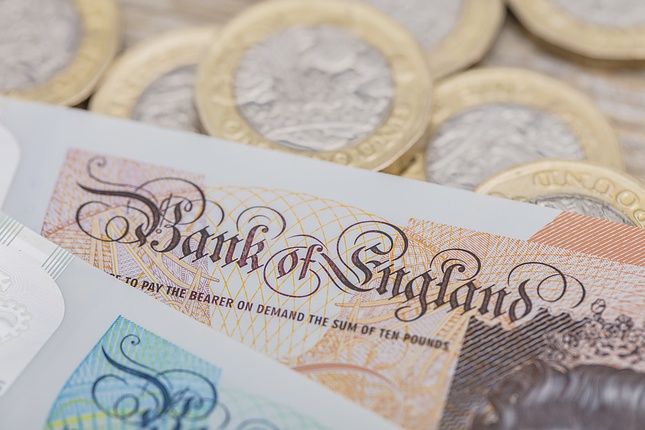- Indian Rupee gains momentum on Tuesday due to the risk appetite and robust Indian economy outlook.
- The upbeat US labour market data and delaying rate cut expectation acts as a tailwind for USD.
- The US March CPI report on Wednesday will be a closely watched event.
Indian Rupee (INR) extends its upside on Tuesday. A positive bias in INR is bolstered by the risk appetite in global markets, Foreign Institutional Investors (FIIs) inflows, and strength in the domestic markets. Nonetheless, the expectation that the Federal Reserve (Fed) might delay the interest rate cuts due to the upbeat US labour market data and the strength of the US economy might lift the Greenback and cap the downside of the USD/INR pair.
Market players will monitor the US March Consumer Price Index (CPI) report on Wednesday for fresh cues about the inflation trajectory in the US. The monthly CPI figure is expected to ease to 0.3% MoM in March from 0.4% in the previous reading. The stronger-than-expected figure in the March report could dampen expectations for Fed rate cuts in June, while softer data could fuel speculation for rate reductions. On the Indian docket, the market will be closed on Thursday for Ramadan Eid. On Friday, the Indian CPI report for March and Industrial Production for February will be released.
Daily Digest Market Movers: Indian Rupee remains firm amid the optimistic outlook for the Indian economy
- India's CPI inflation likely eased to a five-month low of 4.91% in March but remains above the Reserve Bank of India's (RBI) 4% medium-term target as food price rises persist, per economists polled by Reuters.
- RBI Governor Shaktikanta Das said that food price volatility remains a concern as it impacts millions of poor households already heavily dependent on government food subsidies.
- The RBI said that it can manage huge inflows with ease, which means it will be able to buy Dollars and ensure that appreciation is not beyond a certain level.
- RBI stood out with its continued accumulation of gold reserves. Weekly data from the RBI revealed a 6-tonne increase in gold holdings in February alone.
- The Indian central bank continues the accumulation of gold reserves. The weekly data from the RBI indicated that gold holdings rose by 6 tonnes in February alone.
- Minneapolis Fed President Neel Kashkari noted that he penciled in two interest rate cuts this year but if inflation continues to stall, no rate cuts would be a possible scenario.
- Investors have priced in the 50% chance of rate cuts below 50% in June, from about 57% a week earlier, according to the CME’s FedWatch tool.
Technical analysis: USD/INR keeps a bullish vibe in the longer term
The Indian Rupee trades strongly on the day. The bullish stance of USD/INR remains intact in the long term since the pair has risen above a nearly four-month-old descending trend channel since March 22.
In the near term, USD/INR holds above the key 100-day Exponential Moving Average (EMA) on the daily timeframe, with the 14-day Relative Strength Index (RSI) standing in bullish territory around 55.0. This indicates that the further upside looks favorable.
Any follow-through selling below 83.20 (high of March 21), the pair could drop all the way down to the 83.00–83.50 region (round mark, the 100-day EMA), followed by 82.80 (low of March 14). On the upside, a convincing bullish movement above 83.45 (high of April 5) could open the pair to a move back to its all-time high of 83.70 en route to the 84.00 psychological level.
US Dollar price today
The table below shows the percentage change of US Dollar (USD) against listed major currencies today. US Dollar was the weakest against the Swiss Franc.
| USD | EUR | GBP | CAD | AUD | JPY | NZD | CHF | |
| USD | 0.07% | 0.00% | 0.06% | 0.07% | 0.03% | -0.04% | -0.08% | |
| EUR | -0.06% | -0.03% | 0.00% | 0.01% | -0.03% | -0.08% | -0.14% | |
| GBP | -0.02% | 0.05% | 0.05% | 0.07% | 0.01% | -0.03% | -0.09% | |
| CAD | -0.06% | 0.00% | -0.04% | 0.02% | -0.02% | -0.08% | -0.15% | |
| AUD | -0.08% | -0.02% | -0.08% | -0.02% | -0.05% | -0.11% | -0.16% | |
| JPY | -0.03% | 0.03% | -0.02% | 0.02% | 0.06% | -0.07% | -0.13% | |
| NZD | 0.03% | 0.09% | 0.04% | 0.08% | 0.10% | 0.06% | -0.07% | |
| CHF | 0.08% | 0.14% | 0.11% | 0.15% | 0.17% | 0.13% | 0.06% |
The heat map shows percentage changes of major currencies against each other. The base currency is picked from the left column, while the quote currency is picked from the top row. For example, if you pick the Euro from the left column and move along the horizontal line to the Japanese Yen, the percentage change displayed in the box will represent EUR (base)/JPY (quote).
Indian Rupee FAQs
The Indian Rupee (INR) is one of the most sensitive currencies to external factors. The price of Crude Oil (the country is highly dependent on imported Oil), the value of the US Dollar – most trade is conducted in USD – and the level of foreign investment, are all influential. Direct intervention by the Reserve Bank of India (RBI) in FX markets to keep the exchange rate stable, as well as the level of interest rates set by the RBI, are further major influencing factors on the Rupee.
The Reserve Bank of India (RBI) actively intervenes in forex markets to maintain a stable exchange rate, to help facilitate trade. In addition, the RBI tries to maintain the inflation rate at its 4% target by adjusting interest rates. Higher interest rates usually strengthen the Rupee. This is due to the role of the ‘carry trade’ in which investors borrow in countries with lower interest rates so as to place their money in countries’ offering relatively higher interest rates and profit from the difference.
Macroeconomic factors that influence the value of the Rupee include inflation, interest rates, the economic growth rate (GDP), the balance of trade, and inflows from foreign investment. A higher growth rate can lead to more overseas investment, pushing up demand for the Rupee. A less negative balance of trade will eventually lead to a stronger Rupee. Higher interest rates, especially real rates (interest rates less inflation) are also positive for the Rupee. A risk-on environment can lead to greater inflows of Foreign Direct and Indirect Investment (FDI and FII), which also benefit the Rupee.
Higher inflation, particularly, if it is comparatively higher than India’s peers, is generally negative for the currency as it reflects devaluation through oversupply. Inflation also increases the cost of exports, leading to more Rupees being sold to purchase foreign imports, which is Rupee-negative. At the same time, higher inflation usually leads to the Reserve Bank of India (RBI) raising interest rates and this can be positive for the Rupee, due to increased demand from international investors. The opposite effect is true of lower inflation.
Information on these pages contains forward-looking statements that involve risks and uncertainties. Markets and instruments profiled on this page are for informational purposes only and should not in any way come across as a recommendation to buy or sell in these assets. You should do your own thorough research before making any investment decisions. FXStreet does not in any way guarantee that this information is free from mistakes, errors, or material misstatements. It also does not guarantee that this information is of a timely nature. Investing in Open Markets involves a great deal of risk, including the loss of all or a portion of your investment, as well as emotional distress. All risks, losses and costs associated with investing, including total loss of principal, are your responsibility. The views and opinions expressed in this article are those of the authors and do not necessarily reflect the official policy or position of FXStreet nor its advertisers. The author will not be held responsible for information that is found at the end of links posted on this page.
If not otherwise explicitly mentioned in the body of the article, at the time of writing, the author has no position in any stock mentioned in this article and no business relationship with any company mentioned. The author has not received compensation for writing this article, other than from FXStreet.
FXStreet and the author do not provide personalized recommendations. The author makes no representations as to the accuracy, completeness, or suitability of this information. FXStreet and the author will not be liable for any errors, omissions or any losses, injuries or damages arising from this information and its display or use. Errors and omissions excepted.
The author and FXStreet are not registered investment advisors and nothing in this article is intended to be investment advice.
Recommended content
Editors’ Picks

EUR/USD holds steady above 1.0800, looks to post weekly losses
EUR/USD trades marginally higher on the day above 1.0800 after the data from the US showed that Durable Goods Orders declined by 0.8% in September. Nevertheless, the pair remains on track to close the fourth consecutive week in negative territory.

GBP/USD extends recovery to 1.3000 area
GBP/USD extends its recovery and trades at around 1.3000 in the American session on Friday. The US Dollar struggles to gather strength as the market mood remains positive heading into the weekend, allowing the pair to hold its ground.

Gold fluctuates in narrow range below $2,750
Gold stays in a consolidation phase and fluctuates in a relatively tight range below $2,750 on Friday. US Treasury bond yields stabilize in the American session, making it difficult for XAU/USD to gather directional momentum.

Crypto Today: XRP, Bitcoin and Ethereum decline as Ripple files response to SEC appeal
XRP loses over 1.30% as Ripple's executive confirms the filing of an important document in the appeals process in the SEC lawsuit. Bitcoin corrects less than 1% and sustains above $67,500. Ethereum is down nearly 0.20%, holding above the key support level of $2,500.

US elections: The race to the White House tightens
Trump closes in on Harris’s lead in the polls. Neck and neck race spurs market jitters. Outcome still hinges on battleground states.

Best Forex Brokers with Low Spreads
VERIFIED Low spreads are crucial for reducing trading costs. Explore top Forex brokers offering competitive spreads and high leverage. Compare options for EUR/USD, GBP/USD, USD/JPY, and Gold.